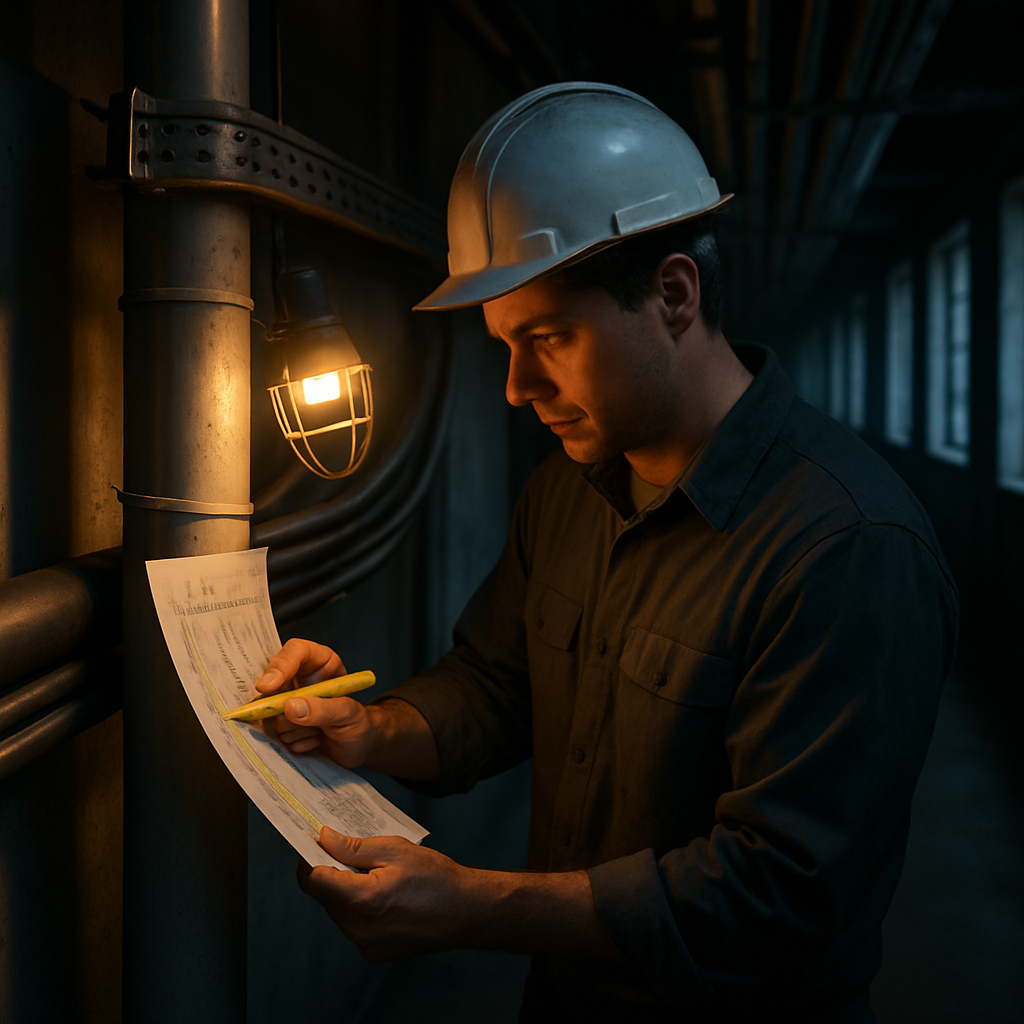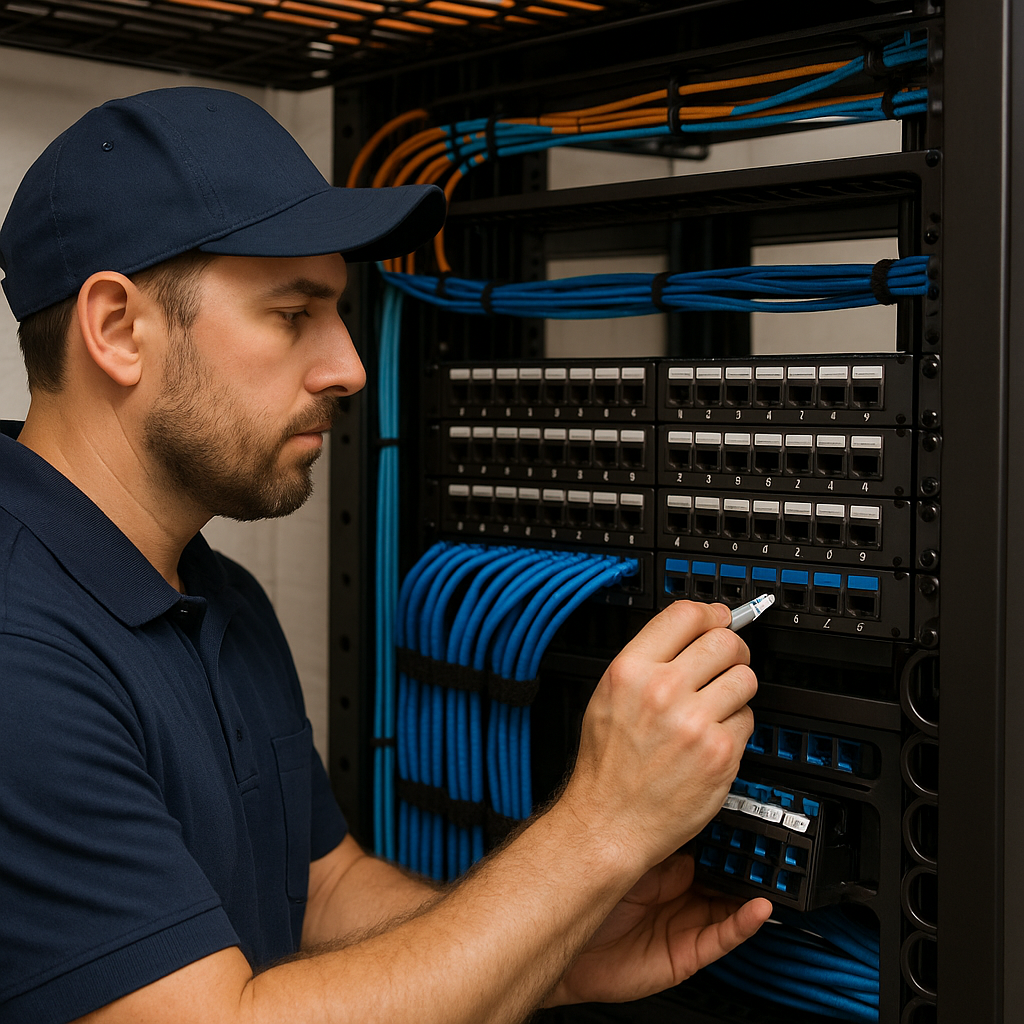How to Troubleshoot Structured Cabling Issues
An unreliable network connection poses a direct threat to productivity, communication, and revenue. When data transmission slows to a crawl or...
8 min read
 Kevin Murphy
:
Nov 24, 2025 10:00:03 AM
Kevin Murphy
:
Nov 24, 2025 10:00:03 AM
Your team complains about slow file downloads, lagging video calls, and random network drops. You’ve upgraded your internet connection and invested in the latest Wi-Fi access points, yet the problems persist. The culprit is often the one part of your network you can’t see: the outdated cabling hidden within your walls and ceilings. Your understanding of structured cabling as the central nervous system of your business is critical. When this foundational infrastructure can no longer keep up with modern data loads and device demands, productivity grinds to a halt.
Recognizing the symptoms of failing or outdated wiring is the first step toward building a more reliable, high-performance network. This diagnostic guide covers the clear signs that your structured cabling needs an upgrade. From tangible performance degradation to the invisible limits of older cable categories, we’ll help you identify the red flags and outline the next steps to modernize your infrastructure for years to come.
Before diving into the details, it helps to have a high-level checklist. If you find yourself nodding along to several of the points below, it's a strong indicator that your cabling infrastructure is the root cause of your network issues. These symptoms often compound, creating widespread performance and reliability problems across your organization.
While one of these issues might be manageable, a pattern of two or more is a clear signal that it's time to consider a comprehensive upgrade. The following sections will explore each of these critical signs in greater detail.
The most immediate and frustrating signs of outdated cabling are performance-related. When your network can't consistently meet the demands of your daily operations, the cabling system is a primary suspect. This degradation occurs because older cables, like Cat5e, were not designed for the volume and complexity of today's data traffic, creating a fundamental bottleneck that no other equipment upgrade can fix.
Are VoIP calls constantly breaking up or video conferences freezing at critical moments? These issues are often caused by high latency and jitter, where data packets arrive inconsistently. Older cabling infrastructure is more susceptible to electromagnetic interference (EMI) and crosstalk, which corrupts data signals. This forces network equipment to re-transmit data, creating the delays you experience as poor call quality or application lag, especially during peak business hours.
Your business may have a 1 Gigabit internet connection, but that speed is meaningless if your internal cabling can only handle a fraction of it under real-world conditions. Outdated cabling acts like a narrow one-lane road during rush hour. For example, a marketing agency trying to upload large video files while the sales team runs a cloud-based CRM will quickly saturate the capacity of a Cat5e system, causing network-wide slowdowns. If your entire office network grinds to a halt when a few users perform data-intensive tasks, your cabling is the bottleneck.
Slow application performance isn't always a software or server issue. Every request your workstation makes—from opening a file on the server to loading a cloud-based dashboard—travels through your physical wiring. Degraded or insufficient cabling increases data transmission errors, which slows down throughput significantly. If you're consistently waiting longer than expected for files to transfer or for applications to become responsive, it may be time to investigate the physical layer of your network.
Technology evolves rapidly, and the demands placed on network infrastructure have grown exponentially. Structured cabling installed a decade ago was never intended to support the high-power, multi-gigabit devices that are now standard. If your attempts to deploy new technology are met with mysterious failures or underperformance, your existing wiring is likely the limiting factor.
Power over Ethernet (PoE) technology is essential for modern offices, powering everything from VoIP phones and Wi-Fi access points to high-definition IP security cameras. Newer PoE standards like PoE+ (802.3at) and PoE++ (802.3bt) deliver 30W to nearly 100W of power, but they require higher-quality cabling to function correctly. Older Cat5e or Cat6 cables can struggle with heat dissipation and voltage drop over long runs, causing PoE devices to randomly reboot or fail to power on entirely, creating significant reliability and security gaps.
Upgrading to the latest Wi-Fi standards like Wi-Fi 6E is a great way to boost wireless performance, but these access points require a multi-gigabit wired connection to deliver their full potential. Connecting a new Wi-Fi 6E access point with a legacy Cat5e cable is like attaching a firehose to a garden spout—the AP's backhaul connection to the network switch is limited to 1 Gbps. To truly benefit from modern wireless speeds, you need a cabling upgrade to Cat6A or better, which supports 2.5GBASE-T, 5GBASE-T, and even 10GBASE-T speeds.
The modern workplace is a dense ecosystem of connected devices beyond just computers and phones. IP-based security systems, access control panels, smart lighting, and IoT sensors all rely on the structured cabling system. An outdated or poorly planned cabling infrastructure can't handle this device density. We recently saw a client in the logistics space whose new IP security system of high-resolution cameras kept failing; their old wiring simply couldn't provide the stable power and bandwidth required, forcing a much-needed upgrade. You can explore our case studies to see more examples like this.
Sometimes, the signs you need an upgrade are visibly apparent in your server room or documentation. Over many years, physical cables degrade, organizational standards slip, and the entire system becomes a liability. Ignoring these physical warning signs can lead to unexpected network downtime and costly emergency repairs.
If your building’s cabling is Category 5e (Cat5e) or older, it’s time to plan for an upgrade. While Cat5e can technically support 1 Gbps speeds, it offers no headroom for future applications and is more vulnerable to performance issues. As of late 2025, the industry standard for new installations is Cat6A, which provides reliable performance for 10 Gbps speeds and is better suited for high-power PoE applications. Relying on Cat5e is a strategic risk that limits your business's technological growth, as confirmed by standards set by the Telecommunications Industry Association (TIA).
A structured cabling system should be able to pass a certification test, which uses specialized equipment to measure its performance against established TIA/ISO standards. If a network technician runs a test and finds high rates of failure due to issues like crosstalk, insertion loss, or incorrect terminations, it's a definitive sign that the infrastructure is unreliable. For businesses in regulated industries like healthcare or finance, failing to meet cabling standards can also create serious compliance vulnerabilities.
Open your server room or network closet door. If you are met with a tangled mess of cables with no clear organization or labeling, you have a major problem. This "spaghetti cabling" makes troubleshooting a nightmare, turning a simple fix into hours of work and increasing the risk of accidentally unplugging a critical system. It is also a clear indicator of an unmanaged system that has likely suffered from improper moves, adds, and changes over the years, hiding a multitude of potential failure points.
Your structured cabling must support your business strategy, not hinder it. Major business milestones—from moving to a new office to expanding your team—are key moments to evaluate whether your current network infrastructure can scale with your ambitions. Proactively upgrading your cabling during these transitions is far more efficient and cost-effective than reacting to failures later on.
An office renovation or move is the single best opportunity to implement a structured cabling upgrade. With walls open and ceilings accessible, installing new cabling is faster, easier, and significantly less disruptive to your daily operations. Trying to retrofit new wiring in a fully operational office is complex and more expensive. Building a modern cabling foundation into your new or renovated space ensures your network is an asset, not a liability, from day one.
Every new employee brings multiple devices that connect to your network—a laptop, a VoIP phone, a smartphone, and more. This linear growth in users creates exponential growth in data traffic. An older cabling system that worked for 25 employees will likely buckle under the strain of 50. If your company is on a growth trajectory, you must ensure your network backbone can handle the increased load without compromising performance for everyone.
The shift from on-premise software to cloud-based services like Microsoft 365, Salesforce, and enterprise video conferencing has fundamentally changed network traffic patterns. These applications require constant, reliable connectivity with low latency to function properly. If your business is adopting more cloud tools or dealing with larger data sets (like high-resolution media or complex design files), your existing cabling may not have the capacity to provide a seamless user experience.
Recognizing that your structured cabling needs an upgrade is the first step. The next is to approach the project strategically to ensure your new network will support your business for the next decade or more. A successful upgrade is about more than just pulling new wires; it requires professional planning, design, and installation.
Before making any decisions, start with a comprehensive assessment of your current infrastructure. A professional cabling technician can use network certification tools to test your existing cable runs and identify specific points of failure. This data-driven approach helps you understand the true scope of the problem and allows an expert to design a structured cabling installation tailored to your building's layout, current technology, and future business goals.
A cabling upgrade is a long-term investment that should last 10-20 years. Don't just solve today's problems—plan for tomorrow's. This means choosing a cabling category that provides ample headroom for growth. For most businesses today, Cat6A is the recommended standard as it reliably supports 10 Gbps speeds and high-power PoE devices. For backbone connections between closets or for data-heavy environments, incorporating fiber optic cable ensures you are ready for 40 Gbps speeds and beyond.
The performance of your new cabling system depends entirely on the quality of the installation. Partnering with certified and experienced professionals ensures that your system is designed and installed according to strict industry standards.
For instance, after helping a regional accounting firm upgrade from a disorganized Cat5e to a fully certified Cat6A system, they reported that our professional termination and labeling cut their mean-time-to-resolution (MTTR) for network port issues by over 35%. Professionals ensure proper cable handling, testing, and documentation for a warrantied system you can rely on.
A cabling upgrade is also a critical opportunity to address safety. In older buildings, abandoned wiring can be a fire hazard, and improper grounding can pose a risk to both personnel and sensitive equipment. A professional installation ensures all new cabling meets local fire and electrical codes, uses the correct cable rating (e.g., plenum-rated for air circulation spaces), and includes proper bonding and grounding to protect your network from electrical surges.
Your structured cabling is the bedrock of your entire IT operation. Paying attention to these warning signs—from poor performance and technology limitations to visible signs of aging—allows you to address issues proactively before they cause major business disruptions. An investment in a modern cabling infrastructure is an investment in your company's productivity, security, and future growth.
If you’re experiencing any of these signs, it’s time to take the next step. Request a cabling upgrade assessment with Turn-Key Technologies today to ensure your network is ready for the challenges of tomorrow. To get started, get in touch with our team of experts.

Kevin has been with Turn-key Technologies since 2012, overseeing cabling teams and managing projects from concept to completion. With deep expertise in structured cabling installations—including fiber optics, Cat5/5e/6/6a, and coax systems—he works closely with clients and engineers to deliver reliable, high-quality solutions on time and on budget.
Certifications:
NJ Division of Consumer Affairs
• Uniform & Construction Code
• Residential Fire Alarm Systems
• Smoke Detection Systems
• NJ Barrier Free Subcode
• ADA & Licensing Law
NYS Licenses
• Security & Fire Alarm License
• Electrical Training Center Fire Alarm Certification
BICSI & Technical
• Designing for PoE Lighting
• Fiber Optic & Connector Termination
• Firestop 101
Other Certifications
• OSHA 30-Hour Construction Safety
• Verkada Certified Engineer
• Avigilon Access Control Manager 6

An unreliable network connection poses a direct threat to productivity, communication, and revenue. When data transmission slows to a crawl or...

One bad decision during cabling installation can leave an entire building with unreliable network infrastructure for years. Cabling infrastructure...

Your school district or library has just invested in a network infrastructure upgrade. The new cabling installation is complete, and now the critical...